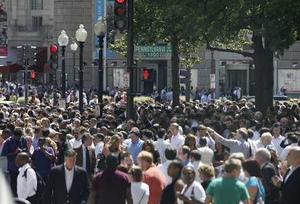DisastersD.C. continues to struggle with orderly evacuations
Last week’s earthquake that struck less than ninety miles outside of Washington, D.C. exposed the city’s continuing difficulties in effectively evacuating its residents; after the 5.9 magnitude earthquake struck the region, commuters were left stranded for hours as road traffic ground to a halt and trains became overcrowded and delayed due to speed restrictions because of the quake

Washington D.C. evacuation continue to be problematic // Source: prensalibre.com
Last week’s earthquake that struck less than ninety miles outside of Washington, D.C. exposed the city’s continuing difficulties in effectively evacuating its residents.
After the 5.9 magnitude earthquake struck the region, employers ended the workday early and in the ensuing mass exodus, commuters were left stranded for hours as road traffic ground to a halt and trains became overcrowded and delayed due to speed restrictions because of the quake. To make matters worse malfunctioning traffic lights and blocked off streets made the commute even more arduous. City officials say that crippling traffic is inevitable and that it is nearly impossible for commuters to leave quickly in a hurry.
“Not only can it not be done, we should not try it,” said Ron Kirby, transportation planning coordinator for the Metropolitan Washington Council of Governments.
Even during normal traffic conditions the city’s streets are clogged. The city’s nineteen evacuation routes are routinely jammed during rush hour due to the large number of employees commuting in and out of the city. D.C.’s population roughly triples from 600,000 to 1.8 million each workday resulting in severe strains on the city’s transportation infrastructure.
“Our population goes up 1.2 million every day, so technically, we evacuate every day,” said Millicent West D.C.’s homeland security director. “The transportation system is fragile on a good day, but we are able to move people out in an orderly fashion.”
Following the earthquake, to help ease traffic and expedite the commute, extra police officers were deployed to assist in controlling traffic and Metro officials activated rush hour train service three hours ahead of schedule. In addition traffic lights on major outbound roads stayed green for longer periods of time and carpool lane restrictions were lifted on highways in northern Virginia.
Aside from these measures, city officials say employers must stagger their release times to help facilitate an orderly evacuation, but the city has struggled to coordinate with its largest employer, the federal government, to create an effective evacuation plan.
Following the 9/11 terrorist attacks, the federal government and city officials recognized the critical need to develop a proper plan after the chaos that followed. Yet, nearly a decade later, a massive snowstorm last winter revealed the city’s continuing inability to develop a proper evacuation plan as commuters struggling to get home were stuck in traffic for twelve hours or more.
Emergency planners blamed the federal government for releasing all of its employees simultaneously as conditions worsened and the federal government was blamed once again for last week’s evacuation nightmare.
Several federal employees cited communications problems, leading many to flee on their own.
“I did not feel like I knew what to do,” said Bill Samuel, who works for the Environmental Protection Agency at its headquarters on Constitution Avenue. “Many people were saying we should evacuate and people spontaneously evacuated EPA’s buildings at the Federal Triangle. However, no official order was ever given to the best of my knowledge.”
Some government agencies gave workers the option to leave at 2:30 pm, but the Office of Personnel Management, which officially determines when offices should open or close during emergencies, did not issue its formal recommendation until 4 pm and most employees did not see the email notice until 4:30.
Kirby said that following an earthquake the Office of Personnel Management or other employers could not have possibly controlled the flow of its workers heading home.
“There was really nobody in position to control demand, because the demand issue was pretty much a building-by-building decision,” he said. “There was no way that could be coordinated.”
